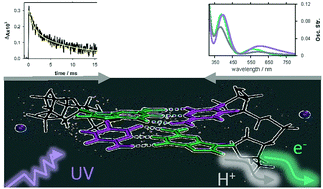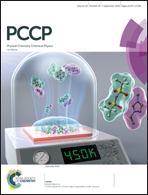Radicals generated in alternating guanine–cytosine duplexes by direct absorption of low-energy UV radiation†
Abstract
Recent studies have evidenced that oxidatively damaged DNA, which potentially leads to carcinogenic mutations and aging, may result from the direct absorption of low-energy photons (>250 nm). Herein, the primary species, i.e., ejected electrons and base radicals associated with such damage in duplexes with an alternating guanine–cytosine sequence are quantified by nanosecond transient absorption spectroscopy. The one-photon ionization quantum yield at 266 nm is 1.2 × 10−3, which is similar to those reported previously for adenine–thymine duplexes. This means that the simple presence of guanine, the nucleobase with the lowest ionization potential, does not affect photo-ionization. The transient species detected after 3 μs are identified as deprotonated guanine radicals, which decay with a half-time of 2.5 ms. Spectral assignment is made with the help of quantum chemistry calculations (TD-DFT), which for the first time, provide reference absorption spectra for guanine radicals in duplexes. In addition, our computed spectra predict the changes in transient absorption expected for hole localization as well as deprotonation (to cytosine and bulk water) and hydration of the radical cation.

- This article is part of the themed collection: 2018 PCCP HOT Articles


 Please wait while we load your content...
Please wait while we load your content...